Special thanks to Mark Ceconi who has edited all my reviews.
First Impressions:
I first paddled the Uno on the ultra flat Charles River back in April 2009 (see clip), thinking to myself; “There is no way I will be able to paddle this in the ocean.” I did not buy it then, but waited until August, after purchasing my V12. When I got home that afternoon and put in on the waters of the Sakonnet River, lo and behold, I discovered I could indeed paddle it in the ocean, with some caveats. What a difference a few months makes. Did my skills improve that much while paddling the V12? Or more to the point were my first impressions (30 minutes of paddling) not initially accurate, or did I just need to put more time in the bucket?
I have logged 30 hours in the Uno since August 10, 2009 in various conditions from flat to 2.5 foot seas. I know, I know, 2.5 foot waves and some of you are saying: “Can’t this guy paddle it in bigger conditions? Well, take a look at the stability and remounting ratings and get back to me. Remember Mid Packer! My roughest outing was along the Beavertail Race Course headed to Mackerel Cove as close to the rocks as I felt safe (10 yards) in some very jobbly refractory waves with my paddling partner, Tim Dwyer, in his V12. The New England paddlers will know these conditions based on the Double Beaver Race Course.
Location. Location. Location: As you’re aware if you have read my other reviews, I paddle primarily on the Sakonnet River, Narragansett Bay, and do most of the races in New England. My three main measured courses are my 6.4 mile course, 11.6 mile course (Sakonnet River Race), and 6 mile course. While it can be very hard to tease out which boats within the same class are faster, I have tried to do so with my Surfski Chart. I feel confident in my assessments due to the overwhelming data that I have accumulated since 2002 in kayaks and mostly surfskis on the above mentioned courses and local races.
Show Me the Facts: Since July 2002 I have logged the stats below for my 3 main courses:
6 mile course, 109 times accumulating 646 miles in 106 hours
6.4 mile course, 197 times accumulating 1212 miles in 204 hours
11.5 mile course, 61 times accumulating 644 miles in 109 hours.
(The numbers are rounded off)
I also have my recorded races since 2002 in various boats as well, and have recorded times of all my paddles that can be sorted by boat since 2002. Furthermore, I have paddled with the same group of guys over the years and can chart my race times compared to them. While all this data is convincing, there are three main variables when trying to assess a boat’s speed:
1. One’s skill level (stability) when paddling the various skis. (This obviously increases over time)
2. One’s fitness level at a given time
3. One’s paddling technique.
I have left out current and wind as variables since I have done these courses so many times; since they are out and back courses, the current and wind generally equal out.
Over the years, my skill level being able to paddle the high performance skis (HPS) has certainly improved. Additionally, my paddling fitness level has improved, evidenced by my race pace heart rate from 2002-2009, as well as comparing my standings in the local races. While my technique is better, it needs work in order to become a faster/more efficient paddler, as Ben Lawry pointed out to me a few weeks ago in a coaching lesson replete with video. The good news is that I have been working on it. My technique has begun to improve.
What Goes Around: As supported by the data, this is a long way of saying that I have a very good feel for the speed of skis, and try very hard to have an objective point of view. On occasion I will ask another paddler what his thoughts were on a particular ski to see if a similar opinion was shared.
Speed:
So how fast is the Uno? The sponsored Elite Think Team have made some believers, demonstrating strong wins and solid showings in the major races across the globe. But how does that translate to the mid pack paddlers? Read On!
I had a PR on my 6 mile course in the Uno, September 3, 2009. On October 3, I had another PR by a few seconds on this same course in the Uno. Both of these time trials eclipsed my previous record held by the Mohican done back in September of 2006. It should be noted that on both occasions I did not set out to break my PR, they were just part of my normal paddling routine. The September 3rd paddle I wore my Garmin 305. I was surprised by how low my heart rate was having just done a PR. I averaged 143 and maxed at 157. My normal average racing heart rate is in the range of 155-165 depending on the distance. The October paddle while I did not wear my Garmin, was no where near race pace effort. Perceived effort felt like it was in the mid 140’s to 150.
I do believe that if I were to time trial the Mohican now, it would out perform any ski in true flatwater (8 inch wavelets or less). To support that claim, I should borrow Chris’s Mohican and time trial it again, since I am a faster paddler now than in 2006. A review of the Mohican is on its way and well over due!
On November 1, I raced the Uno in an 8 mile flatwater race and was pleased with the outcome, 3rd place behind Dave van Dorpe (Nelo Vintage Vanquish), and Chris Chappell (Mohican). The Uno responded well with the 5 inch rudder despite droning through suck water 50% of the race, part of the territory in flatwater racing. I also was able to race it in a Charles River Training Race (4.95 miles) a few months ago, and once again was very pleased with its performance on true flatwater. Chris (Mohican) beat me again in this race. Um, there seems to be a pattern here!!
One thing about the Uno that I confirmed with another Uno owner was that the Uno is deceptively fast, or should I say, flat out very fast. Unless you put a GPS on it, you subjectively feel you are going slower than you really are. Most of us have an internal subjective pace we have honed over the years while racing bikes, kayaks, surfskis, and doing road races. The Uno will certainly surprise you when you look down at your Garmin; I have been on most occasions.
While this review is of a Kevlar Uno, I would also like to compare a carbon Uno (24lbs) to my Kevlar one (28lbs). This would put it in the same weight class as the other ultra light skis. My rule of thumb has been if there is a 4 pound weight difference between skis, and you are racing, you should move to the lighter boat provided you don’t mind a little less stability in the lighter ski. I mention this, because while the Uno accelerates exceedingly well, a carbon version would undoubtedly be even faster.
So how fast is the Uno? Plenty fast!!! Definitely one of the fastest skis on the market. Here, however, is the caveat: For the intermediate to semi-advance paddler, you will have to put your time in the bucket to be able to paddle it at full power in conditions. Your learning curve will vary depending on the make/model of high performance ski you are paddling now.
What else about the Uno should you consider?
Fit:
In my DVD ‘Surfski Basics,’ done along with Mark Ceconi, I devote one section to the importance of fit in a surfski. If a ski does not fit you properly, the speed and stability become far less important. This can not be overstated.
As I have mentioned in my earlier reviews of the Think Evos and Legends, the cockpit design fits me exceedingly well. This theme continues in the Uno. What makes the Think skis work for me is that the height of the bucket to the foot well is optimized in the Uno for great leg drive, even for the shorter paddlers (29.5 inch inseam) like me. This translates to your legs being lower than your seat, setting up a nice platform for optimal power transfer, whether you’re a short or tall paddler.
The Uno has the slimmest profile of all the surfskis (Length: 21′ 3″/ 6.48m, Width: 16.5” /42cm), however, the bucket width seems to fit a variety of paddlers. Like all my skis with the exception of one, I have some padding in cockpit to ensure I have just enough contact with the ski when my leg is partially extended downward upon initiating leg drive.
While most paddlers will have to put their time in the Uno to get used to the stability, what is very nice about the Uno is that it beckons you to keep paddling it due to its extreme level of comfort.
Stability:
I rated the overall stability a 2. While the experienced paddler will quickly adjust to the stability on flatwater, like any ski, the stability in the ocean is a whole ‘nother matter. I moved fairly quickly from flatwater ocean paddling to my two foot seas, combining some mixed condition paddling we typically see here in New England. The Uno’s stability is similar to the Mako 6’s I owned. At some point, you must learn to trust the ski, realizing that heeling it over will not ensue a capsize. This is where time in the bucket is crucial, since all skis feel different in this regard. As I write this, I’m reminded why I bought the Uno in the first place: I needed/wanted a fast ski I could paddle in flat to very moderate New England conditions, where my Think Legends would give up a little speed to faster hulls.
Handling Characteristics:
The Uno tracks very nicely downwind, and is able to hold its line in quartering seas without much input from the rudder. It feels very solid in the water and does not get blown about like various other high performance skis. The bow will bury however, especially in bigger conditions. There is some bow slap upwind, but it is not burdensome. Because of its design, it tends to roll side to side as you paddle it, but you will eventually adjust to this aspect of the Uno by either concentrating on keeping it centered (preferred) or just going with it, and allowing the boat to move underneath you.
I have tried all the rudders, but have settled on the 8 inch rudder for ocean paddling and the 5 inch for flatwater paddling. Remounting is easier than I thought for such a narrow ski, due to the lower gunwales. I switched out the double foot straps for my single Lincke/Timbuk2 strap; it works perfectly. The excellent and precise micro footplate adjustment is the same throughout the Think line. While you do need an allen wrench and a crescent wrench to change rudders, it only takes a few minutes. I have spent many hours changing out Think rudders on all my boats. My main criticism is that the tension on each rudder is slightly different from rudder to rudder. This is not only in the Uno but also in the Legends as well.
Summary:
The Uno is one of the fastest skis on the market. It also numbers amongst the most narrow, and has the least amount of volume. It does require ‘getting acquainted’ with a large degree of bucket time to get used to its late secondary stability in conditions. My Uno feels solid in the water, while being deceptively fast on flat or in ocean conditions. Comfort, leg drive, unique lines, different rudder sizes, and speed, make the Uno a welcome player to the class of high performance surf skis. ~ Wesley
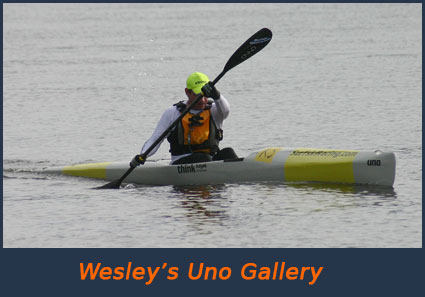
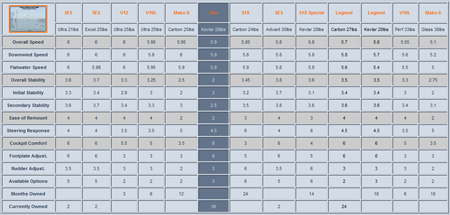
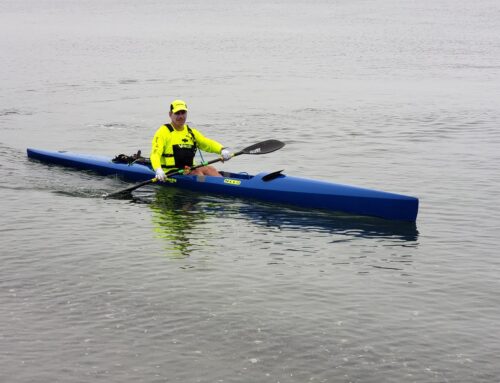
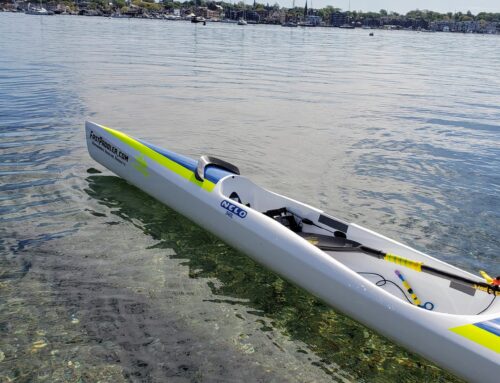
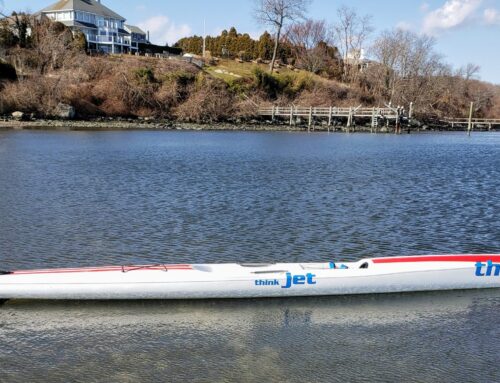
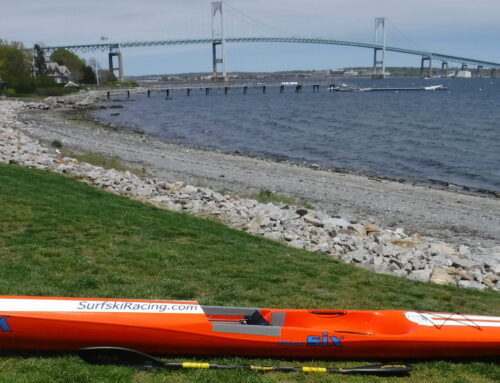
Leave A Comment
You must be logged in to post a comment.